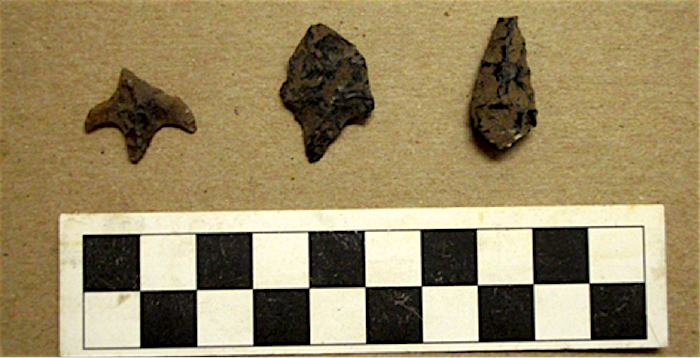
Artifacts thought to have come from an ancient Native American camp on Santa Rosa Island have been discovered beneath a 19th century ranch house/NPS
A prehistoric Native American site thought to date between 8,000 and 13,000 years ago has been unearthed at Channel Islands National Park in California, where officials believe the site might be evidence of a coastal migration following the North Pacific Rim from Northeast Asia into the Americas, part of the peopling of the new world.
Park staff discovered the site while conducting archaeological monitoring during a rehabilitation project of the historic Main Ranch House on Santa Rosa Island. The ancient site was found under the Main Ranch House, part of the historic Vail & Vicker Ranch at Bechers Bay, in the process of lifting the building to construct a new foundation.

The discovery of the prehistoric camp has paused renovations to the ranch house while archaeological site work continues/NPS
“The northern Channel Islands have one of the largest and most significant clusters of early coastal sites in the Americas with more than 100 sites over 7,500 years old,” said Jon Erlandson, University of Oregon archaeologist and leading expert on paleocoastal archaeology. “We suspect the site is at least 10,000 years old, with evidence of some of the earliest people on the West Coast, the first Americans.”
Among the artifacts uncovered were two types of stone tools that are distinctly representative of early North American Paleoindians — Channel Islands barbed points and crescents. Made from local island chert and used for hunting and fishing, they are signatures of a sophisticated technology of early tool making on the Channel Islands.
The early settlement sites on the Channel Islands produced several milestones in archaeology, including the earliest evidence for seafaring and island colonization in North America, the oldest shell middens in North America, and the earliest basketry from the Pacific Coast of North America.
Santa Rosa Island is also the location of the discovery of "Arlington Man," the oldest known human remains found in North America, believed to date to more than 13,000 years ago.
Part of the ancestral homeland of the Island Chumash, many contemporary Chumash families trace their heritage to Santa Rosa Island. There were up to 1,200 Chumash living there in at least nine known historic Chumash village sites, including Hichimin, which was located near the historic main ranch complex.
The Main Ranch House is a prominent building in the historic ranch, which operated as a sheep and cattle ranch for more than 150 years. It was constructed sometime after 1869 and is believed to be one of the oldest wood framed structures in Santa Barbara County.
The National Park Service is involved in a major rehabilitation project on the historic ranch house on Santa Rosa Island for a new use as visitor lodging. This project is being conducted in a manner that preserves the historical integrity of the building. It will include constructing a new foundation, increasing its structural stability, repairing important architectural elements, and making it accessible.
Following this archaeological discovery, work on the ranch rehabilitation project was suspended to conduct an archaeological investigation. An NPS archaeological team, in consultation with the Chumash, is conducting careful test excavations in the vicinity of the ranch house to determine the nature, extent, and integrity of the deposits.
The Park Service is consulting with tribal and preservation partners to monitor this work, to discuss management of the site, and to assess the results of the test excavations in order to determine the best course of action.
“This ancient site is believed to have considerable value, and protecting it is part of the core mission of the NPS and the park’s enabling legislation,” said Channel Islands Superintendent Russell Galipeau. “Our goal is to preserve both of these important and irreplaceable cultural resources found in the park.”

Renovations to the historic ranch house on Santa Rosa Island turned up a much, much older site of human occupation/NPS
Archaeological resources at Channel Islands National Park represent an important aspect of the scientific and cultural significance of the park. National Park Service policy guides the park to protect scientifically significant resources by on-site protection and stabilization, or collection.
Park visitors are encouraged to see and experience these amazing resources, but must leave them in place undisturbed. Collecting, possessing, trafficking in, removing, destroying, injuring, defacing, or disturbing archaeological resources is prohibited by federal law and agency regulations.






Comments
Glad they are taking it slow and careful.